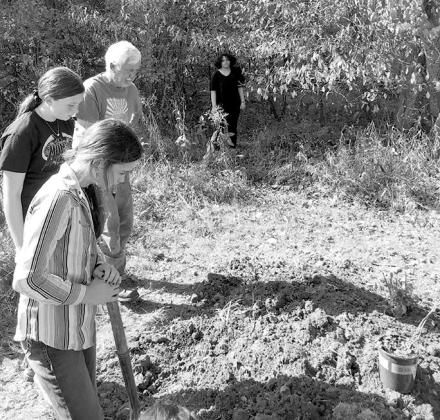By Nila Harris
“It was pretty fun. It got us out of class for the day,” piped up Dorothy Beebe when explaining the fall planting project at Sharp Middle School in which she participated. All joking aside, Beebe was able to describe in detail how she worked with members of the Butler Lion’s Club and her STEM class with teacher David Myers planting native species on SMS’s nature trail.
The Butler Lion’s Club wanted to be involved in a school project that would benefit the school children and be something the members of the club could participate in. When club members approached Superintendent Joe Buerkley about their ideas, Buerkley informed them that there was a new STEM (science, technology, engineering, and math) curriculum being implemented at SMS that would possibly lend to the two groups working together. Lion’s Club members met with Principal Robert Hoover and Myers to brainstorm some ideas.
The two groups decided on a two-day workshop. On the first day, Barth Johnson and JoEllen Mitchell came to the classes to explain what they would be doing—removing the invasive Japanese honeysuckle and integrating native plant species in four ten-foot beds. They discussed the interdependence of plants and wildlife, and botany terms such as “stratification”. Outdoor safety was addressed, and questions were asked and answered. Questions such as What happens when you cut down the invasive honeysuckles? What if you don’t? Why did the native species go away? What in the ecosystem has changed?
Prior to this, Boo Singleton and Johnson prepped the four beds by tilling the land and removing the Asian honeysuckles. A seventh-grade class and an eighth-grade class were taken to the nature trail during their class periods on day two. The classes were split amongst the beds and Lions Club volunteers. Each group had a scribe, someone to create a map, and students involved in the planting. Two plots were placed in partial shade and two in full sun. Soil samples were collected and processed by the conservation district to determine PH levels and what could be done to improve soil quality. JoEllen, who has a degree in environmental science and is a master gardener, determined which seeds to bring and plant. She identified the Japanese honeysuckle, milkweed pods, and locust plants. Students were also told about the animals which frequented the trail: deer, squirrels, chipmunks, moles, and opossums and about erosion issues. They were even given seeds to take home and plant on their own.
The Lion’s Club members said they were pleased with the thoughtful questions the children asked on site, how they interacted with each other and the Lions, how they took over with ideas when planting, and how hard they worked. They also appreciated how Myers took the children out several times and gave them the freedom to explore and discover.
Lion’s Club members who were involved in this project, spearheaded by Bill Mitchell, also included JoEllen Mitchell, Barth Johnson, Boo Singleton, Glenn Bolinger, Larry Miller, Ron Mouser, Joel Nahari, and Herman Schack. The group plans to come back in the spring to see if there is germination, what survived, and which plants the animals seemed to like best. The Lion’s Club has possible ideas of building birdhouses with students for Southern Elementary’s nature trail or take a group to the Cedar Line trail in Butler to plant wildflowers.
Beebe was excited to be able to bring home her own seeds and looks forward to planting in the spring. She isn’t sure which plants will do better on the nature trail but predicts that it will be those planted in the shady area.


